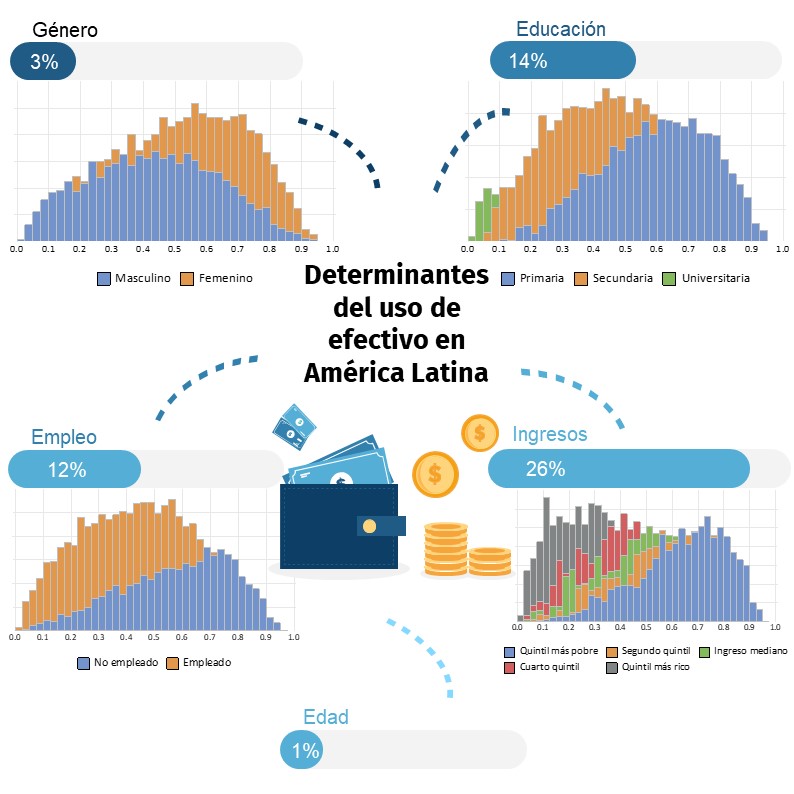Determinantes del Uso de Efectivo en América Latina
##plugins.themes.bootstrap3.article.main##
Resumen
Este documento caracteriza el uso de efectivo en América Latina. Se utilizó la encuesta Global Findex, base de datos del Banco Mundial, para modelar la influencia de diversos factores en la probabilidad de uso de efectivo, mediante un modelo de regresión binaria. El principal hallazgo es que la población femenina, con educación básica, en condiciones de pobreza y desempleo es más propensa a utilizar efectivo en sus transacciones, es decir, que el grado educativo, el nivel de ingresos y el empleo formal influyen en el uso de efectivo.
Descargas
Descargas
Detalles del artículo
Citas
Alfonso V., Tombini A., & Zampolli F., (2020), Retail payments in Latin America and the Caribbean: present and future. https://www.bis.org/publ/qtrpdf/r_qt2012f.pdf
Amromin, G., & Chakravorti, S. (marzo de 2007). Debit card and cash usage: A cross-country analysis. Federal Reserve Bank of Chicago. https://www.chicagofed.org/-/media/publications/working-papers/2007/wp2007-04-pdf
Andrews, D. W. Chi-Square Diagnostic Test for Econometric Models: Theory. Econometrica, 56(6), 1419-1453. https://www.jstor.org/stable/1913105.
Bech, M., Faruqui, U., Ougaard, F., & Picillo, C. (11 de marzo de 2018). Payments are a-changin’ but cash still rules. BIS Quarterly Review, 67-80. https://www.bis.org/publ/qtrpdf/r_qt1803g.pdf
Briglevics, T., & Schuh, S. (Marzo de 2014). U.S. consumer demand for cash in the era of low interest rates and electronic payments. (E. C. Bank, Ed.) [Working Paper Series (1660)]. https://www.ecb.europa.eu/pub/pdf/scpwps/ecbwp1660.pdf
Cabezas L., Jara A. (Diciembre de 2021). Demanda de dinero en efectivo: hechos estilizados y sustitución por medios de pago electrónicos. https://repositorio.cepal.org/handle/11362/47708
Dabla-Norris, E., Deng, Y., Ivanova, A., Karpowicz, I., Unsal, F., VanLeemput, E., y Wong, J. (2015). Inclusión financiera: un enfoque centrado en América Latina. Boletín Octubre-Diciembre. CEMLA.
Greene, W. H. (2003). Bivariate and Multivariate Probit Models en Econometric Analysis (Quinta ed., pp. 170 - 179). Prentice Hall.
Gross, M.B., Hogarth, J. M. & Schmeiser, M., (2012). Use of financial services by the unbanked and underbanked and the potential for mobile financial services adoption. Federal Reserve Bulletin, 98(Sept.). https://doi.org/10.17016/bulletin.2012.98-4
Hosmer, D. W., & Lemeshow, S. (2000). Applied Logistic Regression (Segunda ed.). John Wiley & Sons.
Humphrey, David B., (2004), Replacement of cash by cards in US consumer payments. Journal of Economics and Business, 56(3), 211-225. https://doi.org/10.1016/j.jeconbus.2003.09.001.
Keynes, J.M. (1970). Teoría general de la ocupación el interés y el dinero. Editorial Muñoz S.A.
Kombe, C. A., Yabu, N., Mwita, D. L., & Mbiha, G. E. (2020) Mobile Phone Payments and Demand for Cash: The Case of Tanzania. American Journal of Industrial and Business Management, 10(8), 1505-1573. https://doi.org/10.4236/ajibm.2020.108099
Mukhopadhyay, B. (2016). Understanding cashless payments in India. Financial Innovation, 2(27), 2-26. https://doi.org/10.1186/s40854-016-0047-4
Tobin, J. (1956). The Interest Elasticity of Transaction Demand for Cash. Review of Economics and Statistics. 38(3), 241–247. https://is.muni.cz/el/1456/jaro2013/MPE_NKMA/um/39243250/TobinRES1956.pdf




